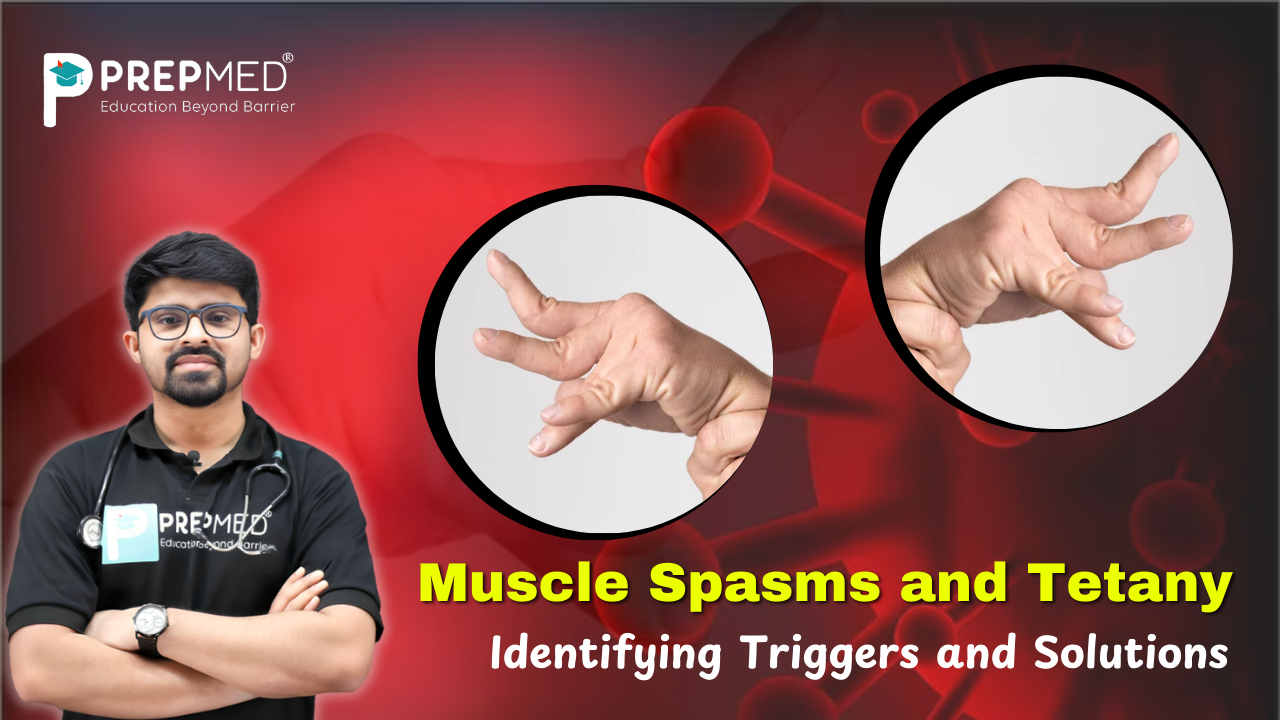January 30, 2025
Muscle Spasms and Tetany: Identifying Triggers and Solutions
The sudden involuntary muscle spasms and cramps along with numbing and tingling sensations especially in hand, feet and face regions give rise to tetany. When electrolytes including calcium, magnesium and potassium become imbalanced, proper muscle operation becomes impaired thus causing tetany. Various medical causes lead to tetany including hypocalcemia and elevated blood pH as well as deficiencies of vitamin D or magnesium.
- Several factors trigger tetany including nutritional deficiencies of calcium or magnesium and kidney disease which disrupt electrolyte stability or any combination of stress, anxiety and hyperventilation and dehydration.
- Blood pH and electrolyte levels change due to stress and anxiety alongside hyperventilation and dehydration as triggering factors.
- Some prescribed medicines including diuretics and chemotherapy drugs enhance the risk of occurrence of tetany.
- Parathyroid gland impairment leads to parathyroid dysfunction when it prevents proper calcium level regulation.
- The correct diagnosis of root causes remains essential to effectively manage and avoid future occurrences of tetany even when the condition is temporary and treatable.
- The treatment of electrolyte imbalances requires dietary modification along with supplements which medical professionals monitor in combination with medical intervention.
What is Tetany? Understanding the Condition
Tetany causes the body to experience wild muscle contractions and sudden spasms. These can be quite severe, leading to pain, discomfort, and in some cases, significant impairment of normal function. Tetany develops when electrolyte imbalances create problems with the levels of calcium potassium and magnesium in the body.
Causes of Tetany:
Hypocalcemia: Low levels of calcium in the blood, often due to vitamin D deficiency, kidney disease, or parathyroid gland disorders.
Hypomagnesemia: The failure of parathyroid hormone production happens when low magnesium levels disrupt the body's calcium management systems.
Hypokalemia: Low potassium levels, often associated with diuretics, excessive vomiting, or diarrhea.
Symptoms of Tetany:
- The hands and feet experience painful muscle cramps alongside spasms.
- Patients experience numbness or tingling sensations which are most noticeable near their mouth.
- Anxiety or irritability
- Seizures in severe cases
How Low Calcium Levels Trigger Tetany Symptoms
Hypocalcemia( characterized by low calcium levels in the body), can lead to a condition called tetany, which is characterized by muscle spasms and involuntary contractions. Calcium is not only crucial in muscle function but also helps in nerve transmission and blood clotting. When calcium levels drop to a significant level, the balance and function of nerves and muscles are disrupted.
Hormones such as parathyroid hormone (PTH) operate to maintain a stable calcium equilibrium within the body. When calcium levels are low, PTH increases calcium absorption from bones, kidneys, and intestines. However, if the body's demand exceeds its supply, it results in hypocalcemia.
A reduced calcium level creates hyperexcitable nerves which results in excessive muscle stimulation. The body experiences excessive nerve stimulation which results in the development of typical tetany symptoms characterized by cramps, spasms, and numbness. The untreated condition leads to symptom escalation which produces more severe conditions including seizures.
Tetany and Its Link to Stress and Anxiety
Tetany causes muscle spasms and involuntary contractions which become more severe under conditions of stress and anxiety. The activation of the fight-or-flight response in stressful situations triggers the body to release stress hormones including adrenaline and cortisol. These hormones can cause changes in electrolyte levels, particularly calcium and magnesium, which are essential for normal muscle function.
Long periods of stress and anxiety create hypocalcemia which dramatically reduces calcium levels and becomes the major trigger for tetany development. The increased hyperexcitability of muscles generates symptoms such as muscle spasms and cramps and tingling sensations.
Regular mindfulness practice guided by medical professionals combined with relaxation techniques enables effective prevention and reduction of tetany symptoms when individuals learn methods to manage their stress and anxiety properly.
Diagnosing Tetany: Tests and Procedures
Blood tests along with diagnostic procedures help identify why wild muscle contractions happen during tetany. Blood tests are vital for diagnosis since they determine specific electrolyte levels of calcium, magnesium and potassium. Decreased levels of electrolytes indicate possible cause for tetany.
Additionally, a healthcare provider may perform a physical examination to observe the characteristic signs of tetany, such as muscle spasms or Trousseau's sign (a spasm in the hand when a blood pressure cuff is applied).
During evaluations medical professionals perform nerve conduction studies (NCS) along with electromyography (EMG) to assess the electrical behavior of muscles and nerves. A correct medical investigation allows doctors to evaluate nerve function for potential irregularities responsible for appearance of symptoms.
How Tetany Affects Muscle Function
- When Tetany occurs muscles experience unwanted spasms which result in unbearable cramps and painful muscle contractions.
- This occurs when low calcium, magnesium, or other electrolyte imbalances interfere with the muscles' ability to relax properly
- Additional muscle excitement leads to muscle tightness and twitching behaviors that typically appear in hands, feet and face areas.
- Muscle spasms that last too long create pain that hinders movements leading to difficulties with daily tasks.
- When electrolyte imbalance treatment is not provided properly, muscular spasms tend to continue or intensify which disrupts natural muscle operation and overall quality of personal life.
Treatment Options for Tetany: From Supplements to Medications
Treatment for tetany consists mainly of correcting the underlying electrolyte imbalance. Muscle spasms often improve through the use of standard calcium and magnesium supplements which help normalize electrolyte levels in the body. Other efforts to correct severe tetany cases may require immediate intravenous delivery of calcium in an institutional medical setting. Healthcare providers recommend chronic tetany sufferers to consider either modifying their diet or taking vitamin D supplements for better calcium absorption. When stress or hyperventilation causes symptoms the doctor might prescribe sedatives or anti-anxiety drugs.
How Dehydration and Electrolyte Imbalances Trigger Tetany
The loss of body fluids results in important electrolyte imbalances that particularly affect the levels of potassium, magnesium, and calcium in the body. The body needs these electrolytes since they serve as fundamental elements for proper muscle and nerve functions. When the body is dehydrated, it loses these critical minerals through sweat and urine.
A decreased electrolyte count creates a state where nerves become easily activated and produce muscle contractions. This imbalance can trigger tetany, characterized by painful muscle spasms and cramps, as the muscles cannot properly relax and contract.
Coping with Tetany: How to Alleviate Muscle Spasms
To get relief from the muscle spasms caused by tetany, it’s important to address the underlying electrolyte imbalance.
- First, ensure proper hydration by drinking plenty of water and consuming electrolyte-rich fluids like sports drinks or oral rehydration solutions.
- Taking calcium or magnesium supplements can help correct deficiencies.
- Gentle stretching and massaging the affected muscles may relieve tension and improve blood flow.
- Breathing exercises can also help reduce stress or hyperventilation, which may trigger spasms. If symptoms persist, consult a healthcare provider for further diagnosis and treatment.






